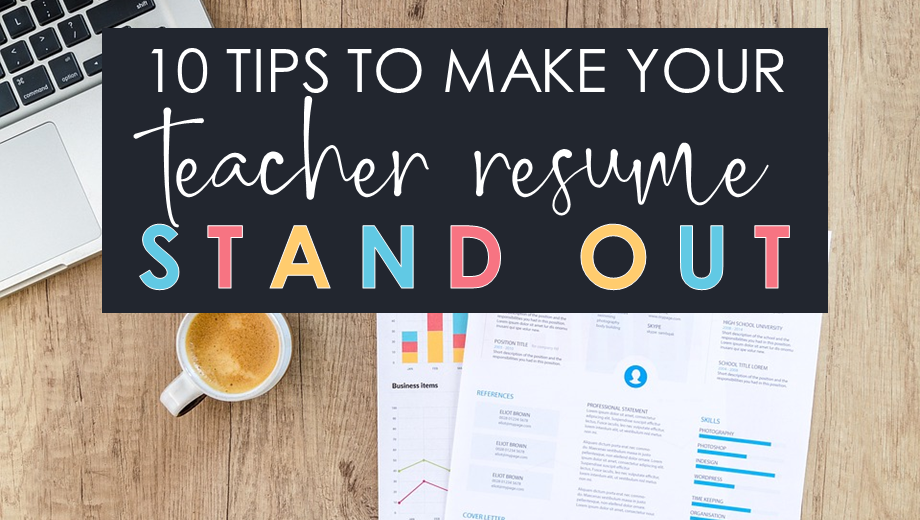The employment of teachers is expected to grow by 5% by 2031. Teachers enjoy job stability, a competitive salary with perks, and the possibility to work close to where they live and teach the subject they love. However, in some districts, schools receive hundreds of resumes for one job opening.
To stand out in the competitive landscape, you need to prepare a resume that showcases your expertise and unique strengths as a teacher. Writing an interview-winning resume can seem daunting, but with today’s tips, you’ll give your resume a quality boost.
Need a strong resume but have no time to write? Consider a teaching resume writing service CV writer. An education resume writing expert will improve your old resume or create a brand-new one, focusing on the qualifications that matter most to the employer. You can get your resume done in 24 hours or 3 days.
8 expert tips for highlighting your teaching experience

Use a reverse-chronological format
Unless you are changing careers and switching to a teaching role, opt for a reverse-chronological resume format. In this format, you list all your teaching jobs starting with the most recent position, including job titles, employer names, and precise dates of employment.
Hiring managers prefer this resume format, as it helps them see a candidate’s work history and career progression.
Write in bullet points, not paragraphs
Formatting your teaching experience in paragraphs is out of date. Instead, use bulleted lists to tell about your responsibilities and accomplishments. Although bullets take up more space, they help readability. A hiring manager can scan through your resume quickly and make sure that your experience aligns with the target role.
Do not include too many bullets for each job – usually, 6-7 bullets are enough to describe the highlights of your experience. Make sure that each bullet takes no more than two lines for better readability.
Speak through accomplishments
Like in any profession, including your teaching accomplishments is essential to help the school understand your value as an educator. Professional accomplishments showcase your initiative and the ability to achieve the goals set. When describing your excellent results, add figures and percentages to illustrate your impact better.
Improving the test scores of your students, implementing multimedia in the curriculum, improving discipline, and updating the curriculum count as professional accomplishments. If you received an award from your school, mention this. Here are some examples of accomplishments for a teacher’s resume:
- Implemented the tailored teaching methodologies that resulted in a 15% average increase in students’ STAR test scores
- Developed a project-based learning module, resulting in 100% of students meeting or exceeding curriculum standards.
Emphasize your technology skills

Modern educators should demonstrate a breadth of technical skills and familiarity with digital collaboration tools. As remote teaching becomes a norm, you need to master even more digital skills to stay competitive in the job market. Here are some of the must-have skills to include on your resume:
Must-have technology skills for a teacher:
- Word processing software
- Spreadsheets
- Electronic presentation software
- Web navigation
- Digital awareness
- Email management
- Installing software
- Computer security
Skills for remote teaching:
- Blackboard teaching
- Videoconferencing
- Screencasting
- Collaborative whiteboarding, etc.
Customize your experience for a target job
Tailor your teaching experience for a specific job you have in mind. This might seem daunting; however, generic resumes don’t work. To get noticed, you need to customize the resume content for the requirements of the specific job posting. If you are applying for a few positions, you might need to emphasize different qualifications and experience.
Use a job posting as your guide – read it carefully and pay attention to the skills and qualifications that matter most for your prospective employer. Make sure that your resume reflects the particular skills and methodologies that the job posting is looking for. If the job involves curriculum development and implementing classroom technology, include your experience in these areas precisely. Such an approach will help you look like an ideal candidate for the job.
Write with ATS in mind

Today, most resumes go through applicant tracking systems (ATS) before a human hiring manager sees them. If your resume is not optimized for ATS, it will get tossed even if you are qualified. So, use an ATS-friendly file format (DOCX or PDF) and simple formatting. Be careful with fancy resume templates, as they might not open correctly on ATS.
To get your resume through the ATS, add keywords from the job posting. Pay attention to skills, qualifications, and credentials the organization is looking for, and include them in your resume. You may add those skills when describing your experience, or create a dedicated Skills section.
Here are the top keywords to include on your teacher’s resume:
- Elementary/secondary education
- Curriculum development
- Distance learning
- Lesson planning
- Discipline management
- Blackboard
- Canvas
- Instructional strategies
- Student-centered instruction
- Child development.
Keep your Experience section concise
Experienced educators should go back no more than 10 years in their resume. Otherwise, your resume will exceed the recommended two-page length. Schools and learning centers are interested in your most recent experience in the first place, so you can cut off jobs you had 15 years ago. To keep your resume focused and concise, you may also remove any jobs irrelevant to your teaching career.
Focus on relevant education and credentials
Your relevant education and licenses play a key role in considering you for the position. In most states, having at least a Bachelor’s degree and a teacher’s license are a must to apply for teaching jobs. Some positions require credits in a particular discipline or even a Master’s degree. Make sure that your resume reflects your degree and additional education.
In the education sphere, any additional training and certifications are greatly appreciated. If you are a Microsoft Certified Educator (MCE) or a Child Development Associate (CDA), it may give you a head start over other candidates.
If you have graduated less than 2 years ago, put the Education section at the top of your resume. Otherwise, place it after your professional experience.
Use the best practices to create a standout teaching resume

After crafting a compelling Education section, use these best practices in resume writing to refine and strengthen your document:
Consider additional teacher’s resume sections
Including your experience, education, and skills on your teacher’s resume is essential. Yet, depending on your background, you might also need the additional resume sections. For example, if you know French or German, you can add a specific Languages section and specify your proficiency. Or, you can mention teaching-related hobbies and interests. Memberships in teaching associations will also help you get noticed by your target school.
Add a persuasive summary
A Summary is a great place to introduce your personality, show off your biggest strengths, and present your teaching philosophy. In it, you may also explain the career transition (if you’re changing industries), or mention the awards or in-demand skills that can help you land an interview. Keep this section to 3-4 sentences and focus on the most relevant qualifications for your target role.
Keep it to 1-2 pages
As a rule, entry-level teaching professionals should keep their resume to one page, and experienced educators can use a two-page document. Do not exceed the two-page limit, as most hiring managers don’t like long resumes and don’t read them carefully.
Use clear headings
Organize the resume content so that it has a clear structure. Use standard headings for subsections, such as Education, Skills, Professional Experience, etc. Boldface the job titles and school names. Thus, you will make the resume easier to scan.
Proofread before sending

59% of hiring managers can reject a resume with typos or poor grammar. Submitting an error-free entry is even more important for a teacher, as you need to demonstrate superior attention to detail and great writing skills. To avoid confusing mistakes, proofread the resume a few times before sending it. Use an online spell checker to spot the most common mistakes, and read it aloud to find awkward phrases and improve the word choice.
A good teaching resume should demonstrate your relevant experience, accomplishments in helping students succeed, and strong educational background. With the above-listed tips, you’ll create a persuasive resume that showcases your qualifications for the chosen position. If you feel confused, do not hesitate to contact an experienced resume writer for help. Good luck with your job search!



















